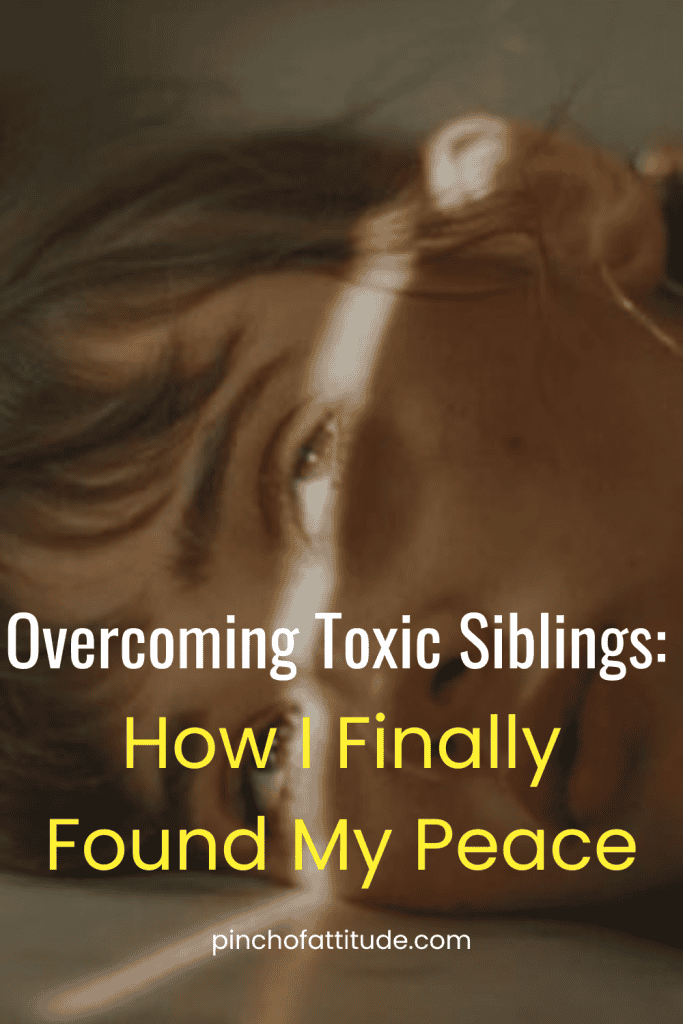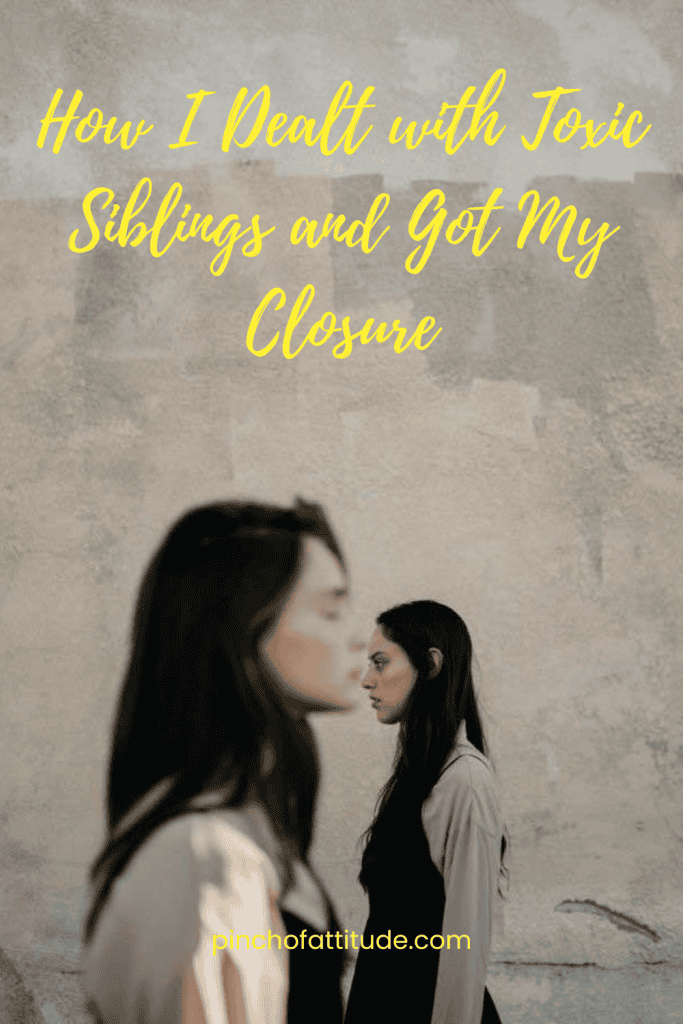If you’ve ever carried the weight of unresolved issues with a sibling, you know the rollercoaster of emotions that comes with taking that first step toward healing.
It’s a journey that can feel pretty overwhelming yet surprisingly freeing and one that I’ve personally decided to dive into.
This was what happened: five years of radio silence between me and my older sister, the tension was thick, and I knew I couldn’t keep dodging the inevitable.
So, I gathered up the courage to confront her, to confront our past, and to finally get some closure.
The experience wasn’t all nice, but I had an important realization after meeting with her, which helped me find closure within myself.
In this blog, I’ll be sharing insights from my own journey, along with some practical tips for navigating those tricky sibling dynamics.
Stick around as we unpack this adventure together – it’s a tale of healing, growth, and finding peace.
- Finding closure after a toxic sibling relationship starts with understanding what you truly need for peace and healing.
- It’s important to acknowledge and accept your emotions, including hurt, anger, or frustration, resulting from a toxic relationship.
- Accept that certain aspects are beyond your control and that letting go of unrealistic expectations or false hope is essential for your own peace of mind.
Table of Contents
How Can You Find Closure After Ending a Toxic Sibling Relationship?

When I asked my sister to meet after five years of not talking to confront her about our situation, I was so nervous.
I actually wasn’t a big fan of confrontation, but this was something I had to do for myself.
She was just as nervous, I could feel it, as she couldn’t look me in the eye. She only gave me the kind of interaction where she acted uninterested, played cool, you know, you get the gist.
I was so disappointed and thought at first that it was a waste of time.
But, not long after, I came to the realization that she really won’t give me that closure . . . because that’s what toxic siblings do.
They just don’t care about your feelings no matter how much you try to make them see you.
It didn’t actually hit me right in the beginning, but that was the closure I was looking for.
That realization opened up the door to my healing journey because I was finally able to understand and accept that our relationship just couldn’t be saved.
It was sad and I mourned the relationship we’d had before, but because of that confrontation, I finally learned to let go.
Here are nine things that really helped me find closure and peace within myself.
1. Figure Out What You Need
Finding closure after cutting ties with a toxic sibling begins with tuning into your own needs. Take a moment to think about what would genuinely bring you peace and healing.
For me, it was a mix of accepting the situation, understanding where we went wrong, and summoning the guts to let go of all that negativity.
Sit down quietly and really think. Ask yourself: Do I need to accept what happened? Do I want to understand why things unfolded the way they did?
Is forgiveness a part of my healing journey? Or perhaps it’s simply about shedding all that negativity.
Tip
Figuring out what you need will be your guide on this journey toward closure. Don’t rush it – this step is key to moving forward.
2. Acknowledge What You’re Feeling
It’s totally fine to recognize and accept your emotions, especially when you’re dealing with the aftermath of a toxic sibling relationship. Believe me, I get it.
Take a moment to really acknowledge your feelings. Are you still hurting from past interactions? Feeling angry about the toxicity that was there between you and your sibling?
Maybe you’re just upset about how much it all affected you emotionally.
Owning up to my feelings was a big turning point in my healing journey.
I allowed myself to feel the hurt and frustration, understanding that these feelings were totally valid given the circumstances.
It’s crucial to let yourself go through and process these emotions without being too hard on yourself.
3. See Things as They Are
Take a moment to really acknowledge the dynamics of your relationship with your sibling – the good, the bad, and the downright toxic.
It’s not about sugarcoating or pretending everything’s okay, but about facing it with honesty and courage.
Accepting the reality of my sibling relationship was tough. I had to accept that some things were out of my control or ability to change and that it was a part of my story that I couldn’t erase.
Tip
Acceptance doesn’t mean you’re okay with the behavior or pretending everything’s fine. It’s about recognizing the truth and finding peace with it, so you can move forward without carrying unrealistic expectations or false hope.
4. Get Your Thoughts Down on Paper
Sit down and really think about your experiences with your sibling and how they’ve messed with your emotions.
Grab a pen and some paper – writing it all out can be seriously therapeutic. Trust me, I’ve leaned hard on journaling during my own healing journey.
Journaling was like having a secret hideout to dive deep into the messiness of my sibling relationship.
I’d ask myself stuff like, “How does my sibling’s drama mess with my head?” or “What can I do to keep myself sane in all of this?”
Getting it all out on paper not only helps you make sense of your feelings but also gives you some real clarity and insight into your journey.
Plus, you can look back later and see how far you’ve come, celebrating the wins, no matter how small.
5. Free Yourself From Resentment
If you’ve been carrying around resentment and anger toward a sibling, I get how heavy that can weigh you down.
To lighten that load, recognize any lingering resentment you might still have. It’s totally okay to feel these emotions, but hanging onto them can really hold you back from finding closure.
For me, letting go of resentment happened little by little. I realized that holding onto anger was just keeping me stuck in the past, unable to move forward. I had to actively work on releasing it.
Start by understanding how resentment affects your well-being. Ask yourself, “What good does it do to hold onto this bitterness?”’
Try your best to forgive so you can free yourself from that emotional weight.
6. Be Your Own Best Friend
Imagine giving yourself the same kindness and understanding you’d give to your best friend. Yep, you deserve that level of love and care too.
In my case, being my own best bud meant allowing myself to feel, to stumble, and to heal in my own time. I realized I was doing the best I could in a tough spot, and that was totally okay.
Tip
When those moments of self-doubt sneak up, remind yourself that you’re handling things as best as you can with what you’ve got. Let yourself feel whatever comes up without beating yourself up over it.
7. Connect With Those Who Lift You
Shift your focus toward building up those healthy, supportive relationships in your life – the ones that lift you no matter what.
During my healing journey, I sought out friends and family who genuinely cared about how I was doing and understood what I was going through.
Their support and understanding gave me a sense of belonging and inner strength.
Make a conscious effort to nurture these important connections. Reach out to your trusted people, share your journey, and let yourself soak in the love and support they have to offer.
8. Develop Your Best Self
Put your energy into activities that help you grow and feel good about yourself. Invest time in things that highlight your strengths, boost your confidence, and make you more resilient.
Because I was eager to become successful, I worked on myself. I chased after my dream and went for things that gave me purpose and made me feel good.
Now, I still continue to succeed in life – something that I didn’t really think I could achieve back then because my mother always made me feel as if I’d be a failure all my life.
Tip
Figure out what you’re good at and what you love, then go after opportunities to develop them further. Set goals that get you excited and push you to become the best version of yourself.
9. Believe in Your Ability to Heal
Years ago, I had to remind myself that healing doesn’t follow a straight line—it’s a journey that unfolds in its own time.
I trusted myself to handle the ups and downs, knowing that each step forward was proof of my resilience.
It’s safe to say that this strategy worked wonders for me. So, just keep your heart open to the idea of healing, even if it feels like a slow and twisty road.
Believe in your own strength and resilience to tackle whatever comes your way. Celebrate every little win along the way, and be kind to yourself during the tough patches.
Tip
You’ve got the power to rewrite your story and embrace a future full of potential and growth.
Signs That You’re Starting to Get Over a Toxic Sibling Dynamic

As you keep moving forward on your path to closure, you’ll start seeing some good signs.
These signs show that you’re making real progress in healing and taking charge of your emotional well-being.
Take these positive changes as proof of how strong and resilient you are as you work towards closing the chapter on a toxic sibling relationship.
When you spot these signs, it means you’re right in the middle of your closure journey.
You Have Less Emotional Turmoil
As you start to bounce back from that toxic sibling dynamic, you might feel a shift in how you handle your emotions.
The heavy stuff like hurt, anger, or resentment that used to weigh you down begins to lighten up.
You’ll catch yourself having more calm and peaceful moments, even when your sibling crosses your mind.
You Become More Self-Aware
Healing’s like digging deeper into yourself and figuring out what makes you tick emotionally.
You start noticing how those toxic vibes from your sibling have messed with you and influenced how you react.
Being aware of all this gives you the power to make choices that put your well-being first.
Setting Healthy Boundaries is Easier for You
As you keep healing, you’ll find it gets simpler to set and stick to healthy boundaries. You’ll get better at recognizing which of your sibling’s behaviors are okay and which are just not cool.
These boundaries are like shields that protect your emotional and mental space.
You Focus Your Energy Toward Positive Things
A big sign that you’re moving forward is when you start putting your energy into positive stuff.
Instead of getting stuck on old grudges or pointless fights, you start diving into things that help you grow and feel good.
This change in focus shows you’re taking back control of your life and what really matters to you.
How Do You Avoid Setbacks in Your Journey Towards Closure From a Toxic Sibling?
As you’re working through healing from a toxic sibling relationship, it’s totally normal to hit some roadblocks.
Now, here’s the deal: you gotta be ready to tackle those hurdles head-on. Anticipate the curveballs, get your head in the game, and prep yourself mentally and emotionally.
When the going gets tough, you’ll be armed with the resilience and grit to push through.
Here’s the lowdown on some hurdles you might face and how to handle them:
- Setting boundaries: Make it crystal clear with your sibling what’s cool and what’s not when it comes to how you communicate and interact. Stick to these rules consistently.
- Dealing with emotional triggers: Get in touch with your feelings. Figure out what really sets you off about your sibling and find ways to deal with it – maybe some deep breathing, mindfulness, or chatting with a close friend or therapist.
- Breaking negative patterns: If you notice you’re falling into the same old toxic routine, flip the script. Focus on being open and assertive in your communication, steering clear of those old, drama-filled habits.
- Overcoming self-doubt: Cut yourself some slack. Don’t beat yourself up over doubts or guilt. Remind yourself that you deserve to put yourself first.
- Avoiding old habits: Stay committed to your healing path, even if you slip up now and then. Setbacks happen. Use them as chances to fine-tune your approach.
Tackling these challenges head-on and having a plan in place puts you in the driver’s seat on your journey to healing from a tough sibling relationship.
Related Posts:
- Healing Emotional Scars After Sibling Toxicity: How I Did It!
- Understanding and Processing Grief in Toxic Sibling Relationships
- How I Managed Anger and Resentment Towards My Toxic Siblings?
- How to Move On After Cutting Ties With Your Toxic Siblings?
- Cultivating Your Inner Confidence Against Sibling Toxicity
Frequently Asked Questions
How can I find closure after ending a toxic sibling relationship?
To find closure, start by understanding your own needs and what will bring you peace. Reflect on accepting the situation, understanding what went wrong, and letting go of negativity.
What should I do if I still feel hurt or angry after cutting ties with a toxic sibling?
It’s important to acknowledge and accept your emotions. Allow yourself to feel the hurt and frustration without being too hard on yourself. Owning up to your feelings is a crucial step in your healing journey.
How do I overcome emotional baggage from a toxic sibling relationship?
Begin by acknowledging the dynamics of your relationship honestly, including the toxic aspects. Accepting this reality is key to finding peace and moving forward without unrealistic expectations.
What strategies can I use to navigate my healing journey from a toxic sibling relationship?
Consider journaling about your experiences and emotions. Writing can be therapeutic, providing clarity and insight into your journey. Additionally, focus on releasing resentment to lighten your emotional burden.
How do I avoid setbacks in my journey towards closure from a toxic sibling relationship?
Prepare yourself mentally and emotionally for potential roadblocks like setting boundaries, managing emotional triggers, and breaking negative patterns. Stay committed to your healing path and be kind to yourself through setbacks.





Closure is when find all answers I’ve been asking myself so long,there’s only one person can give me that.theraph never helped,only helps how cope with situations